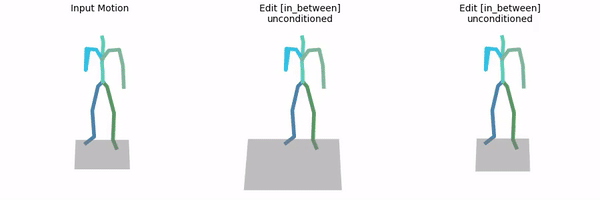The official PyTorch implementation of the paper "Human Motion Diffusion Model".
Please visit our webpage for more details.
If you find this code useful in your research, please cite:
@inproceedings{
tevet2023human,
title={Human Motion Diffusion Model},
author={Guy Tevet and Sigal Raab and Brian Gordon and Yoni Shafir and Daniel Cohen-or and Amit Haim Bermano},
booktitle={The Eleventh International Conference on Learning Representations },
year={2023},
url={https://openreview.net/forum?id=SJ1kSyO2jwu}
}
🐉 SinMDM - Learns single motion motifs - even for non-humanoid characters.
👯 PriorMDM - Uses MDM as a generative prior, enabling new generation tasks with few examples or even no data at all.
🍏 PhysDiff - Adds physical guidance to MDM to generate more realistic results.
💃 EDGE - Learns music-to-dance motion with MDM and off-the-shelf audio encoder.
📢 1/Jun/23 - Fixed generation issue (#104) - Please pull to improve generation results.
📢 23/Nov/22 - Fixed evaluation issue (#42) - Please pull and run bash prepare/download_t2m_evaluators.sh from the top of the repo to adapt.
📢 4/Nov/22 - Added sampling, training and evaluation of unconstrained tasks.
Note slight env changes adapting to the new code. If you already have an installed environment, run bash prepare/download_unconstrained_assets.sh; conda install -y -c anaconda scikit-learn to adapt.
📢 3/Nov/22 - Added in-between and upper-body editing.
📢 31/Oct/22 - Added sampling, training and evaluation of action-to-motion tasks.
📢 9/Oct/22 - Added training and evaluation scripts.
Note slight env changes adapting to the new code. If you already have an installed environment, run bash prepare/download_glove.sh; pip install clearml to adapt.
📢 6/Oct/22 - First release - sampling and rendering using pre-trained models.
This code was tested on Ubuntu 18.04.5 LTS and requires:
- Python 3.7
- conda3 or miniconda3
- CUDA capable GPU (one is enough)
Install ffmpeg (if not already installed):
sudo apt update
sudo apt install ffmpegFor windows use this instead.
Setup conda env:
conda env create -f environment.yml
conda activate mdm
python -m spacy download en_core_web_sm
pip install git+https://github.com/openai/CLIP.gitDownload dependencies:
Text to Motion
bash prepare/download_smpl_files.sh
bash prepare/download_glove.sh
bash prepare/download_t2m_evaluators.shAction to Motion
bash prepare/download_smpl_files.sh
bash prepare/download_recognition_models.shUnconstrained
bash prepare/download_smpl_files.sh
bash prepare/download_recognition_models.sh
bash prepare/download_recognition_unconstrained_models.shText to Motion
There are two paths to get the data:
(a) Go the easy way if you just want to generate text-to-motion (excluding editing which does require motion capture data)
(b) Get full data to train and evaluate the model.
HumanML3D - Clone HumanML3D, then copy the data dir to our repository:
cd ..
git clone https://github.com/EricGuo5513/HumanML3D.git
unzip ./HumanML3D/HumanML3D/texts.zip -d ./HumanML3D/HumanML3D/
cp -r HumanML3D/HumanML3D motion-diffusion-model/dataset/HumanML3D
cd motion-diffusion-modelHumanML3D - Follow the instructions in HumanML3D, then copy the result dataset to our repository:
cp -r ../HumanML3D/HumanML3D ./dataset/HumanML3DKIT - Download from HumanML3D (no processing needed this time) and the place result in ./dataset/KIT-ML
Action to Motion
UESTC, HumanAct12
bash prepare/download_a2m_datasets.shUnconstrained
HumanAct12
bash prepare/download_unconstrained_datasets.shDownload the model(s) you wish to use, then unzip and place them in ./save/.
Text to Motion
python -m sample.generate --model_path ./save/humanml_trans_enc_512/model000200000.pt --num_samples 10 --num_repetitions 3python -m sample.generate --model_path ./save/humanml_trans_enc_512/model000200000.pt --input_text ./assets/example_text_prompts.txtpython -m sample.generate --model_path ./save/humanml_trans_enc_512/model000200000.pt --text_prompt "the person walked forward and is picking up his toolbox."Action to Motion
python -m sample.generate --model_path ./save/humanact12/model000350000.pt --num_samples 10 --num_repetitions 3python -m sample.generate --model_path ./save/humanact12/model000350000.pt --action_file ./assets/example_action_names_humanact12.txtpython -m sample.generate --model_path ./save/humanact12/model000350000.pt --action_name "drink"Unconstrained
python -m sample.generate --model_path ./save/unconstrained/model000450000.pt --num_samples 10 --num_repetitions 3By abuse of notation, (num_samples * num_repetitions) samples are created, and are visually organized in a display of num_samples rows and num_repetitions columns.
You may also define:
--deviceid.--seedto sample different prompts.--motion_length(text-to-motion only) in seconds (maximum is 9.8[sec]).
Running those will get you:
results.npyfile with text prompts and xyz positions of the generated animationsample##_rep##.mp4- a stick figure animation for each generated motion.
It will look something like this:
You can stop here, or render the SMPL mesh using the following script.
To create SMPL mesh per frame run:
python -m visualize.render_mesh --input_path /path/to/mp4/stick/figure/fileThis script outputs:
sample##_rep##_smpl_params.npy- SMPL parameters (thetas, root translations, vertices and faces)sample##_rep##_obj- Mesh per frame in.objformat.
Notes:
- The
.objcan be integrated into Blender/Maya/3DS-MAX and rendered using them. - This script is running SMPLify and needs GPU as well (can be specified with the
--deviceflag). - Important - Do not change the original
.mp4path before running the script.
Notes for 3d makers:
- You have two ways to animate the sequence:
- Use the SMPL add-on and the theta parameters saved to
sample##_rep##_smpl_params.npy(we always use beta=0 and the gender-neutral model). - A more straightforward way is using the mesh data itself. All meshes have the same topology (SMPL), so you just need to keyframe vertex locations.
Since the OBJs are not preserving vertices order, we also save this data to the
sample##_rep##_smpl_params.npyfile for your convenience.
- Use the SMPL add-on and the theta parameters saved to
- This feature is available for text-to-motion datasets (HumanML3D and KIT).
- In order to use it, you need to acquire the full data (not just the texts).
- We support the two modes presented in the paper:
in_betweenandupper_body.
python -m sample.edit --model_path ./save/humanml_trans_enc_512/model000200000.pt --edit_mode in_betweenYou may also define:
--num_samples(default is 10) /--num_repetitions(default is 3).--deviceid.--seedto sample different prompts.--edit_mode upper_bodyFor upper body editing (lower body is fixed).
The output will look like this (blue frames are from the input motion; orange were generated by the model):
- As in Motion Synthesis, you may follow the Render SMPL mesh section to obtain meshes for your edited motions.
Just add the text conditioning using --text_condition. For example:
python -m sample.edit --model_path ./save/humanml_trans_enc_512/model000200000.pt --edit_mode upper_body --text_condition "A person throws a ball"The output will look like this (blue joints are from the input motion; orange were generated by the model):
Text to Motion
HumanML3D
python -m train.train_mdm --save_dir save/my_humanml_trans_enc_512 --dataset humanmlKIT
python -m train.train_mdm --save_dir save/my_kit_trans_enc_512 --dataset kitAction to Motion
python -m train.train_mdm --save_dir save/my_name --dataset {humanact12,uestc} --cond_mask_prob 0 --lambda_rcxyz 1 --lambda_vel 1 --lambda_fc 1Unconstrained
python -m train.train_mdm --save_dir save/my_name --dataset humanact12 --cond_mask_prob 0 --lambda_rcxyz 1 --lambda_vel 1 --lambda_fc 1 --unconstrained- Use
--deviceto define GPU id. - Use
--archto choose one of the architectures reported in the paper{trans_enc, trans_dec, gru}(trans_encis default). - Add
--train_platform_type {ClearmlPlatform, TensorboardPlatform}to track results with either ClearML or Tensorboard. - Add
--eval_during_trainingto run a short (90 minutes) evaluation for each saved checkpoint. This will slow down training but will give you better monitoring.
Text to Motion
- Takes about 20 hours (on a single GPU)
- The output of this script for the pre-trained models (as was reported in the paper) is provided in the checkpoints zip file.
HumanML3D
python -m eval.eval_humanml --model_path ./save/humanml_trans_enc_512/model000475000.ptKIT
python -m eval.eval_humanml --model_path ./save/kit_trans_enc_512/model000400000.ptAction to Motion
- Takes about 7 hours for UESTC and 2 hours for HumanAct12 (on a single GPU)
- The output of this script for the pre-trained models (as was reported in the paper) is provided in the checkpoints zip file.
python -m eval.eval_humanact12_uestc --model <path-to-model-ckpt> --eval_mode fullwhere path-to-model-ckpt can be a path to any of the pretrained action-to-motion models listed above, or to a checkpoint trained by the user.
Unconstrained
- Takes about 3 hours (on a single GPU)
python -m eval.eval_humanact12_uestc --model ./save/unconstrained/model000450000.pt --eval_mode fullPrecision and recall are not computed to save computing time. If you wish to compute them, edit the file eval/a2m/gru_eval.py and change the string fast=True to fast=False.
This code is standing on the shoulders of giants. We want to thank the following contributors that our code is based on:
guided-diffusion, MotionCLIP, text-to-motion, actor, joints2smpl, MoDi.
This code is distributed under an MIT LICENSE.
Note that our code depends on other libraries, including CLIP, SMPL, SMPL-X, PyTorch3D, and uses datasets that each have their own respective licenses that must also be followed.




